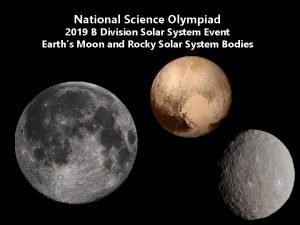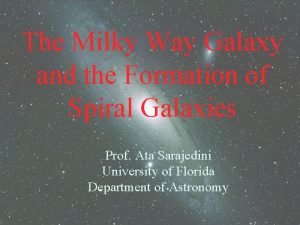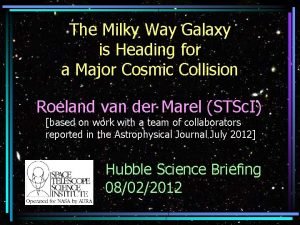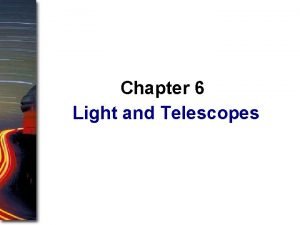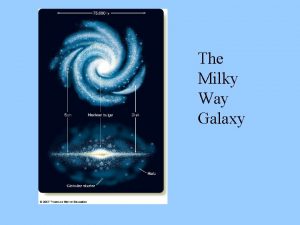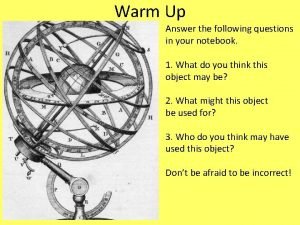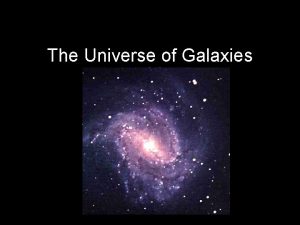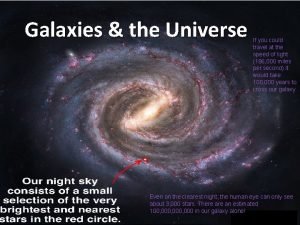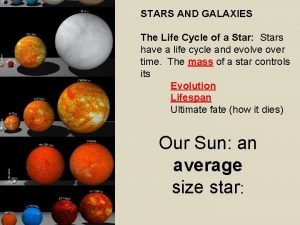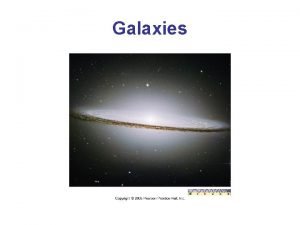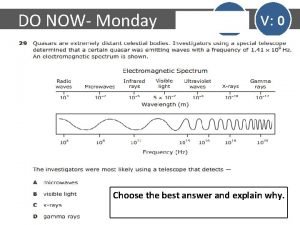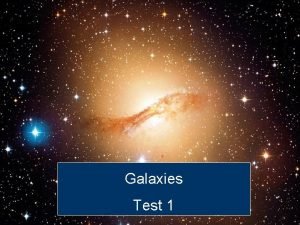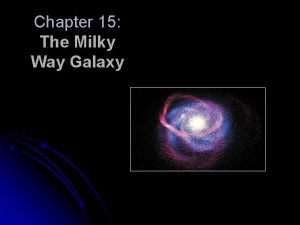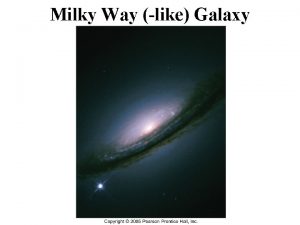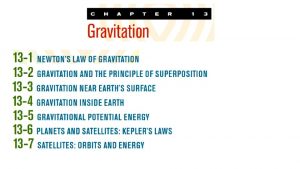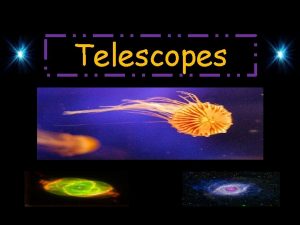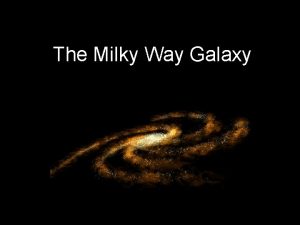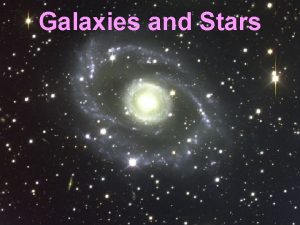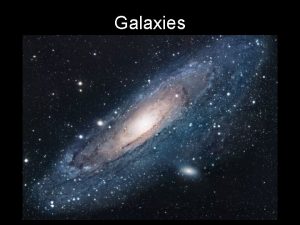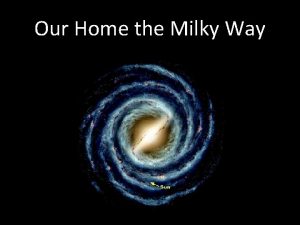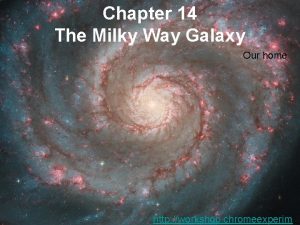Chapter 16 Galaxies Guidepost Our Milky Way Galaxy




































- Slides: 36

Chapter 16 Galaxies

Guidepost Our Milky Way Galaxy is only one of the many billions of galaxies visible in the sky. This chapter will expand your horizon to discuss the different kinds of galaxies and their complex histories. Here you can expect answers to five essential questions: • What do galaxies look like? • How do astronomers measure the distances to galaxies? • Do other galaxies contain supermassive black holes and dark matter, as does our own galaxy? • Why are there different kinds of galaxies?

Guidepost (continued) As you begin studying galaxies, you will discover they are classified into different types, and that will lead you to insights into how galaxies form and evolve. It will also answer an important question about scientific methods: • How does classification help scientists understand nature? In the next chapter, you will discover that some galaxies are violently active, and that will give you more clues to the evolution of galaxies.

Outline I. The Family of Galaxies A. The Discovery of Galaxies B. How Many Galaxies are there? C. The Shapes of Galaxies II. Measuring the Properties of Galaxies A. Distance B. The Hubble Law C. Diameter and Luminosity D. Mass E. Supermassive Black Holes in Galaxies F. Dark Matter in Galaxies G. Gravitational Lensing and Dark Matter

Outline (continued) III. The Evolution of Galaxies A. Clusters of Galaxies B. Colliding Galaxies C. The Origin and Evolution of Galaxies D. The Farthest Galaxies

Galaxies • Star systems like our Milky Way • Contain a few thousand to tens of billions (10121013)of stars. • Large variety of shapes and sizes

Galaxy Diversity Even seemingly empty regions of the sky contain thousands of very faint, very distant galaxies Large variety of galaxy morphologies: Spirals Ellipticals Irregular The Hubble Deep Field: (some interacting) 10 -day exposure on an apparently empty field in the sky

Galaxy Classification Ellipticals: Spirals: Sa E 0, …, E 7 E 0 = Spherical Large nucleus; tightly wound arms E 1 Sb Sc E 7 = Highly elliptical E 6 Small nucleus; loosely wound arms

Gas and Dust in Galaxies Spirals are rich in gas and dust Ellipticals are almost devoid of gas and dust Galaxies with disk and bulge, but no dust are termed S 0

Barred Spirals • Some spirals show a pronounced bar structure in the center • They are termed barred spiral galaxies • Sequence: SBa, …, SBc, analogous to regular spirals

Irregular Galaxies Often: result of galaxy collisions / mergers Often: Very active star formation (“Starburst galaxies”) The Cocoon Galaxy NGC 4038/4039 Some: Small (“dwarf galaxies”) satellites of larger galaxies (e. g. , Magellanic Clouds) Large Magellanic Cloud

Distance Measurements to Other Galaxies (1) a) Cepheid Method: Using Period – Luminosity relation for classical Cepheids: Measure Cepheid’s Period Find its luminosity Compare to apparent magnitude Find its distance b) Type Ia Supernovae (collapse of an accreting white dwarf in a binary system): Type Ia Supernovae have well known standard luminosities Compare to apparent magnitudes Find its distances Both are “Standard-candle” methods: Know absolute magnitude (luminosity) compare to apparent magnitude find distance.

Cepheid Distance Measurement Repeated brightness measurements of a Cepheid allow the determination of the period and thus the absolute magnitude. Distance

Distance Measurement Using Type Ia Supernovae Remember: Type Ia supernovae (collapse of an accreting white dwarf) have almost uniform luminosity → Absolute magnitude Observe apparent magnitude Distance

The Most Distant Galaxies At very large distances, only the general characteristics of galaxies can be used to estimate their luminosities distances. Cluster of galaxies at ~ 4 to 6 billion light years

Distance Measurements to Other Galaxies (2): The Hubble Law E. Hubble (1913): Distant galaxies are moving away from our Milky Way, with a recession velocity, vr, proportional to their distance d: vr = H 0*d H 0 ≈ 70 km/s/Mpc is the Hubble constant • Measure vr through the Doppler effect infer the distance

The Extragalactic Distance Scale • Many galaxies are typically millions or billions of parsecs from our galaxy. • Typical distance units: Mpc = Megaparsec = 1 million parsec Gpc = Gigaparsec = 1 billion parsec • Distances of Mpc or even Gpc The light we see left the galaxy millions or billions of years ago!! • “Look-back times” of millions or billions of years

Galaxy Sizes and Luminosities Vastly different sizes and luminosities: From small, lowluminosity irregular galaxies (much smaller and less luminous than the Milky Way) to giant ellipticals and large spirals, a few times the Milky Way’s size and luminosity

Rotation Curves of Galaxies From blue / red shift of spectral lines across the galaxy infer rotational velocity Observe frequency of spectral lines across a galaxy. Plot of rotational velocity vs. distance from the center of the galaxy: Rotation Curve

Determining the Masses of Galaxies 三條不同波長 的譜線顯現一 樣的 rotation curve 波長 Based on rotation curves, use Kepler’s 3 rd law to infer masses of galaxies

Masses and Other Properties of Galaxies

Supermassive Black Holes From the measurement of stellar velocities near the center of a galaxy: Infer mass in the very center central black holes! Several million, up to more than a billion solar masses! Supermassive black holes

Dark Matter Adding “visible” mass in: • stars, • interstellar gas, • dust, …etc. , we find that most of the mass is “invisible”! • The nature of this “dark matter” is not understood at this time. • Some ideas: brown dwarfs, small black holes, exotic elementary particles.

Gravitational Lensing According to General Relativity, light will be bent towards a massive object when passing it. This phenomenon is called Gravitational Lensing It can be used to detect otherwise invisible Dark Matter and measure its mass.

Clusters of Galaxies generally do not exist in isolation, but form larger clusters of galaxies. Rich clusters: Poor clusters: 1, 000 or more galaxies, diameter of ~ 3 Mpc, condensed around a large, central galaxy Less than 1, 000 galaxies (often just a few), diameter of a few Mpc, generally not condensed towards the center

Our Galaxy Cluster: The Local Group Milky Way Small Magellanic Cloud Large Magellanic Cloud M 31: 仙女座 大星雲系 Andromeda galaxy

Neighboring Galaxies Some galaxies of our local group are difficult to observe because they are located behind the center of our Milky Way, from our view point.

The Canis Major Galaxy The Canis Major Dwarf Galaxy has orbited around the Milky Way a number of times, and tidal forces have ripped away stars and gas.

Interacting Galaxies Cartwheel Galaxy Particularly in rich clusters, galaxies can collide and interact. Galaxy collisions can produce ring galaxies and NGC 4038/4039 tidal tails. Often triggering active star formation: starburst galaxies

Tidal Tails Example for galaxy interaction with tidal tails: The Mice Computer simulations produce similar structures.

Simulations of Galaxy Interactions Numerical simulations of galaxy interactions have been very successful in reproducing tidal interactions like bridges, tidal tails, and rings.

Mergers of Galaxies NGC 7252: Probably result of merger of two galaxies, about one billion years ago: Small galaxy remnant in the center is rotating backward! Radio image of M 64: Central regions rotating backward! Multiple nuclei in giant elliptical galaxies

Interactions of Galaxies with Clusters When galaxies pass through the thin gas of their home cluster, their own gas can be almost completely stripped away.

Starburst Galaxies Starburst galaxies: Galaxies in which stars are currently being born at a very high rate. Starburst galaxies contain many young stars and recent supernovae, and are often very rich in gas and dust; bright in infrared: ultraluminous infrared galaxies

The Farthest Galaxies The most distant galaxies visible by HST are seen at a time when the universe was only ~ 1 billion years old.

Mid-term make-up question by 蘇恩寧 Q: The first question of our mid-term exam tells us that the farthest star can be seen by naked eyes should be 5167 light years away. Why are we able to see Andromeda galaxy (M 31) which is about 2. 54 million light years away without aid when the night sky is clear? A: Surely we can’t see a star which is 2. 54 million light years from us, but obviously Andromeda galaxy itself isn’t a star but is made up of a great amount of stars. We can consider a galaxy as a very big star, which is much bigger (high diameter) than a single star so that the light intensity is also higher. [not completely wrong, but not necessary true: Just because of the great distance between us and Andromeda galaxy we can’t distinguish between 2 single stars in the galaxy even with a telescope. ]
 Galaxie s
Galaxie s Solar system science olympiad
Solar system science olympiad Canis major overdensity
Canis major overdensity Milky way galaxy sketch
Milky way galaxy sketch Most galaxies in the inner region of a large cluster are
Most galaxies in the inner region of a large cluster are Our location in the milky way
Our location in the milky way Raising the stakes guidepost
Raising the stakes guidepost Guidepost of light
Guidepost of light Milky way description
Milky way description Where is the solar system located in the milky way
Where is the solar system located in the milky way Democritus milky way
Democritus milky way Dung beetle milky way
Dung beetle milky way The milky way
The milky way Milkyway fonterra
Milkyway fonterra Are the stars we see at night in our galaxy
Are the stars we see at night in our galaxy Our home galaxy
Our home galaxy Our home galaxy
Our home galaxy Chapter 30 galaxies and the universe
Chapter 30 galaxies and the universe Limewater
Limewater Zjezd
Zjezd Nemertea
Nemertea Milky appearance of plasma
Milky appearance of plasma The electromagnetic spectrum includes
The electromagnetic spectrum includes Life cycle of a galaxy
Life cycle of a galaxy Facts about elliptical galaxies
Facts about elliptical galaxies Th eirregulars
Th eirregulars Era of galaxies
Era of galaxies Types of galaxies
Types of galaxies Brainpop galaxies quiz answers
Brainpop galaxies quiz answers 4 types of galaxies
4 types of galaxies How are active galaxies classified?
How are active galaxies classified? Tipus de galaxies
Tipus de galaxies Properties of elliptical galaxies
Properties of elliptical galaxies Evolution of galaxies
Evolution of galaxies Billions of galaxies
Billions of galaxies Galaxies lesson plan
Galaxies lesson plan Thinking affects our language, which then affects our:
Thinking affects our language, which then affects our:

